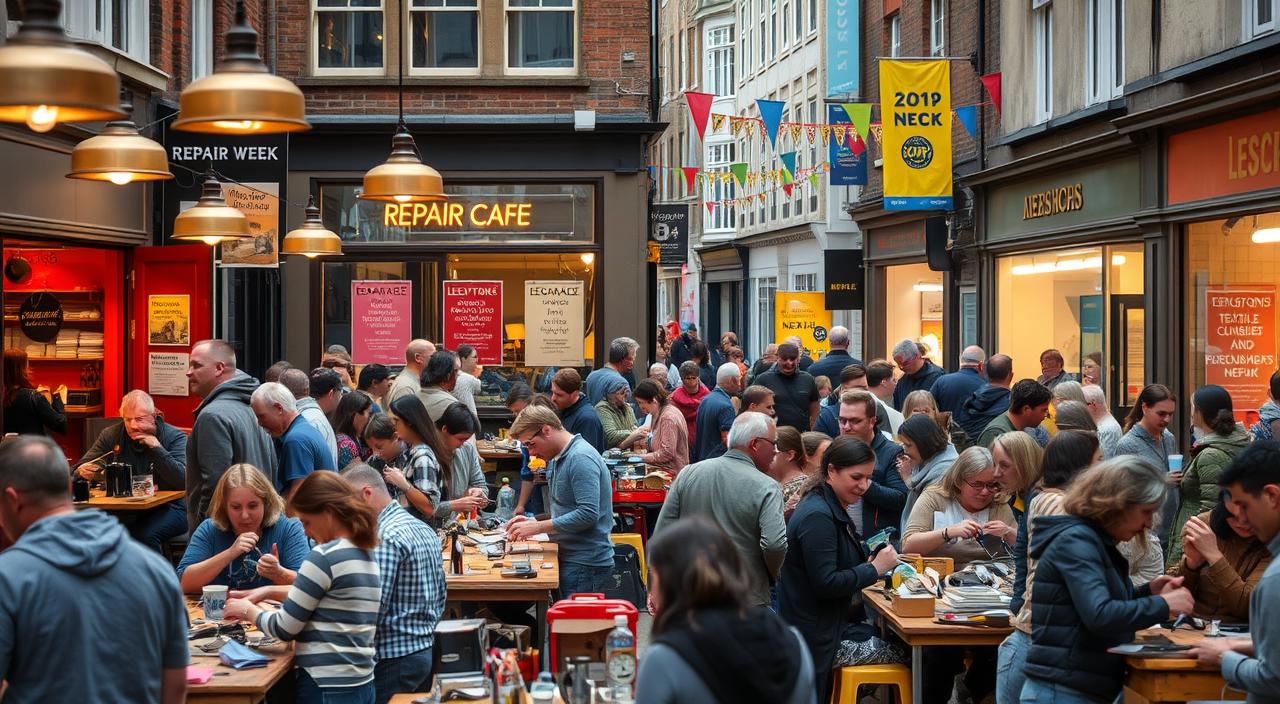
In recent years, London has witnessed a remarkable transformation in how its residents approach their possessions. A growing number of people are moving away from a throwaway mindset, embracing a culture that prioritizes sustainability and longevity. This shift, often referred to as the rise of repair culture in London, reflects a broader commitment to environmental consciousness and reducing waste. Recent data shows that 93% of Londoners have repaired an item in the past year, a significant jump from 72% in 2020. This trend is fueled by concerns about the climate emergency, with 75% of residents believing that repairing items can play a vital role in addressing environmental challenges.

This article explores the factors driving this movement, key initiatives like London Repair Week, and the challenges and solutions shaping the future of sustainable practices in the capital. By examining the data, events, and policies, we’ll uncover why Londoners are increasingly choosing to fix rather than discard.
Key Takeaways
- Widespread Adoption: 93% of Londoners have repaired an item in the past year, signaling a strong shift toward sustainable practices.
- Environmental Motivation: The movement is driven by a desire to reduce waste and combat the climate emergency.
- Youth Engagement: Younger generations, particularly 18-34-year-olds, are leading the charge in adopting repair habits.
- Supportive Initiatives: Events like London Repair Week and voucher schemes are fostering a community of fixers.
- Long-Term Impact: Extending product lifespans through repairs significantly reduces carbon emissions and household waste.
The Growing Popularity of Repair Practices in London
The rise of repair culture in London marks a significant departure from the city’s once-prevalent throwaway mentality. Recent research from the London Recycles campaign highlights that 93% of residents have repaired an item in the past year, compared to 72% in 2020. This shift reflects a growing awareness of the environmental impact of discarding items and a desire to adopt more sustainable habits.
The data also reveals that 69% of Londoners would fix more household items if they had the necessary skills. This enthusiasm for repair is not just about saving money but also about contributing to a greener future. By extending the lifespan of products, residents are reducing waste and minimizing the carbon emissions associated with manufacturing new goods.
For more insights on sustainable living, check out our blog post on Eco-Friendly Practices for Urban Dwellers.
From Throwaway to Keep-and-Fix Mindset
Contrary to the stereotype that younger generations are more wasteful, the data shows that 18-24-year-olds (85%) and 25-34-year-olds (83%) are among the most active in repairing items, compared to just 47% of those over 55. This shift is driven by a combination of economic pressures and heightened environmental awareness. Younger Londoners are motivated by both the cost savings of repairing items and the opportunity to reduce their ecological footprint.
The move toward a keep-and-fix mentality is also supported by a growing number of resources and communities dedicated to repair. For example, platforms like iFixit provide tutorials and tools to help individuals fix everything from electronics to clothing, empowering Londoners to take repairs into their own hands.
How the Pandemic Shaped Repair Habits
The COVID-19 pandemic played a pivotal role in transforming Londoners’ approach to their possessions. With lockdowns limiting access to repair shops and encouraging people to spend more time at home, many residents turned to fixing items themselves. According to the London Recycles campaign, 25% of Londoners reported that the slower pace of life during the pandemic led them to repair more items.
This period also saw a surge in self-taught repair skills, particularly among younger residents. The table below highlights the percentage of Londoners who learned repair skills during the lockdown:
| Age Group | Percentage Teaching Themselves Repair Skills |
|---|---|
| All Londoners | 28% |
| 25-34-year-olds | 31% |
This trend was especially pronounced among 25-34-year-olds, with 31% teaching themselves to fix items. The sense of accomplishment and cost savings from these efforts has cemented repair as a lasting habit for many.
For tips on developing repair skills, explore our guide on Learning DIY Repairs at Home.
London Repair Week: Building a Community of Fixers

One of the most significant drivers of repair culture in London is the annual London Repair Week, held from March 14 to 20. This event brings together over 40 organizations, including retailers, councils, and community groups, to promote the benefits of fixing items rather than discarding them. It serves as both an educational platform and a celebration of sustainable practices.
What is London Repair Week?
London Repair Week offers a range of workshops, tutorials, and events designed to teach residents how to repair items or connect them with local repair professionals. From clothing mending sessions to electronics repair demonstrations, the event fosters a sense of community among fixers.
Key Partners and Initiatives
Major retailers like Primark and Currys play a significant role in the event. Primark hosts “Love it for Longer” workshops in stores across Hammersmith, Oxford Street East, and Westfield, while Currys offers discounts on in-store repair services. Other organizations, such as TRAID and Crisis, contribute by running clothing repair workshops and sharing expert tips.
The table below outlines some of the key participants and their contributions:
| Organization | Event/Type of Support | Location |
|---|---|---|
| Primark | “Love it for Longer” repair workshops | Hammersmith, Oxford Street East, Westfield |
| Currys | Discounts on in-store repair services | Various Currys stores |
| TRAID | Clothing repair workshops | Various locations across London |
London Repair Week not only helps individuals fix specific items but also encourages a long-term shift in consumer behavior. By connecting residents with repair professionals and resources, it builds a sustainable ecosystem that supports repair culture in London.
For more on community-driven sustainability, read our post on Community Initiatives for a Greener London.
Challenges and Solutions in the Repair Movement
While the repair movement in London is gaining momentum, it faces several challenges that could hinder its growth. Addressing these obstacles is crucial to ensuring the long-term success of sustainable repair practices.
The Skills Gap in Repair Services
One of the biggest hurdles is the shortage of skilled repair technicians. As many experienced professionals retire, there are not enough younger workers entering the field to meet the growing demand for repair services. This skills gap threatens the sustainability of repair businesses across the capital.
Repair Voucher Scheme: A European Inspiration
To make repairs more affordable, a repair voucher scheme is being trialed in north London, offering 50% off the cost of fixing broken electrical items. This initiative draws inspiration from a successful program in Austria, where 1.5 million repair vouchers have been used since 2022, saving an estimated 4,000 tonnes of e-waste. By reducing the financial barrier to repairs, such schemes encourage more residents to choose fixing over replacing.
Learn more about innovative waste reduction strategies in our article on Reducing E-Waste in Urban Areas.
Training the Next Generation
To address the skills shortage, new training programs are being introduced to teach repair skills to younger generations. Incorporating these skills into educational frameworks can help bridge the gap and ensure a steady supply of skilled technicians. Organizations like Possible are also working to establish repair hubs across London, providing hands-on training and resources.
These solutions not only support the repair movement but also contribute to reducing household waste and carbon emissions, aligning with broader environmental goals.
The Environmental Impact of Repair Culture
Repairing items instead of discarding them has a significant environmental impact. By extending the lifespan of products, Londoners are reducing the demand for new goods, which in turn lowers the carbon emissions associated with manufacturing and transportation. Additionally, repairs help divert waste from landfills, contributing to a circular economy.
The rise of repair culture in London is also influencing policy discussions. Campaigners are advocating for measures such as removing VAT on repair parts and labor and implementing product design standards that make repairs easier. These changes could further amplify the environmental benefits of the movement.
Conclusion: A Sustainable Future for London
The rise of repair culture in London reflects a growing commitment to sustainability and environmental responsibility. With 93% of residents repairing items annually and initiatives like London Repair Week fostering a community of fixers, the capital is leading the way in sustainable practices. The challenges of skills shortages and repair costs are being addressed through innovative solutions like voucher schemes and training programs, ensuring the movement’s longevity.
As Londoners continue to embrace repair over replacement, the city is setting an example for others to follow. Residents can contribute by learning repair skills, supporting local repair businesses, and advocating for policies that promote sustainability. Together, these efforts can reduce London’s carbon footprint and pave the way for a greener, more sustainable future.
For more ways to get involved, check out our guide on Supporting Sustainable Practices in Your Community.

 CALL NOW
CALL NOW